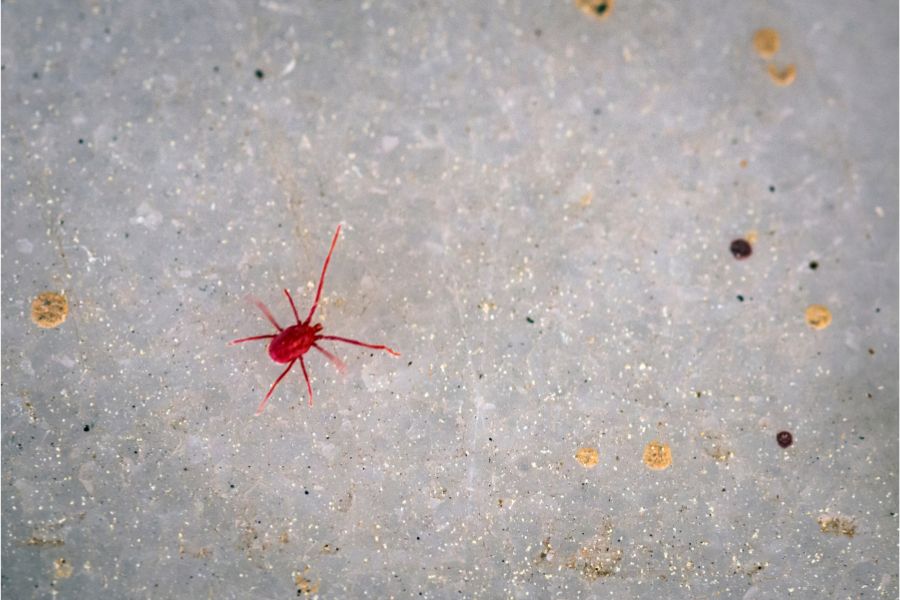Have you recently noticed tiny red or black dots moving on your chickens or tick-like creatures on their nesting materials?
You are likely dealing with a mite infestation.
Like lice and fleas, mites can seriously impact your flock’s health and happiness. They suck blood from your birds, which causes scratching, baldness, and reduced activity.
In case of severe infestation, your birds can develop anemia, feather damage, or even die.
But the good news is this guide walks you through the different types of mites, how they spread, and effective ways to eliminate them.
We hope by the end of this piece, you will learn how to banish these pesky little pests and bring your birds more joy.
What Are Chicken Mites?
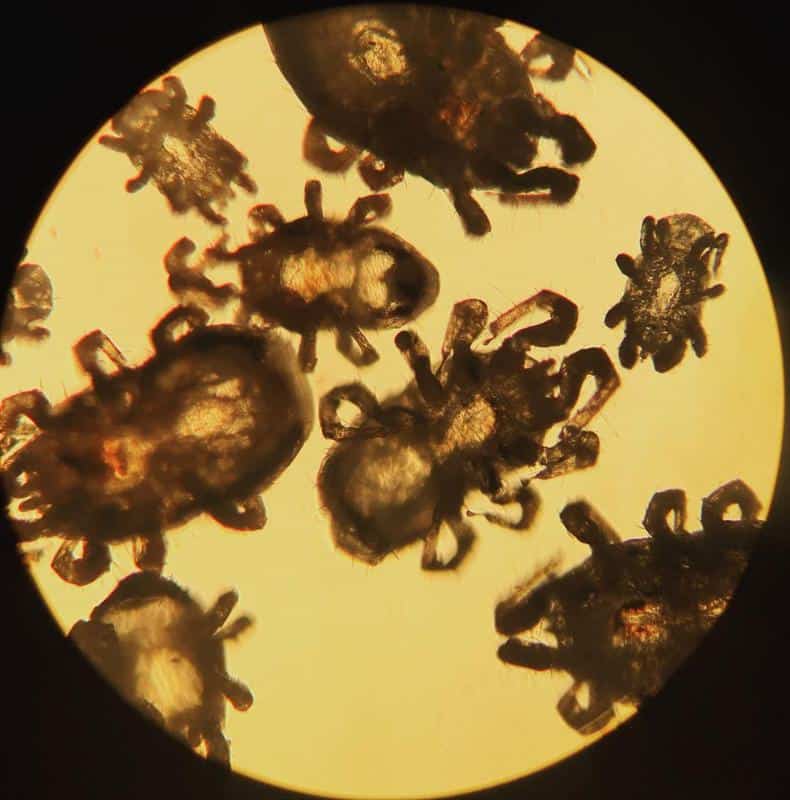
Mites (Dermanysus gallinae) are bloodthirsty external parasites that live to drain your birds dry.
Before they feed on the bird’s blood, they are hard to identify due to their light grey coloration, which makes them nearly invisible. But once the mites are full, they turn red and sometimes black.
What makes them a nuisance is their elusive nature. They only come out to feed during the night. But as daylight approaches, they scram from the host’s body and find safety in crevices and dark corners of the coop.
If that’s not enough, they are hardy and resilient and can survive without blood for as long as seven months. Not to mention their high reproduction rate. Female mites can lay 4 to 8 eggs per day.
That said, there are several types of chicken mites, namely:
1. Scaly Leg Mites (Knemidocoptes mutans)
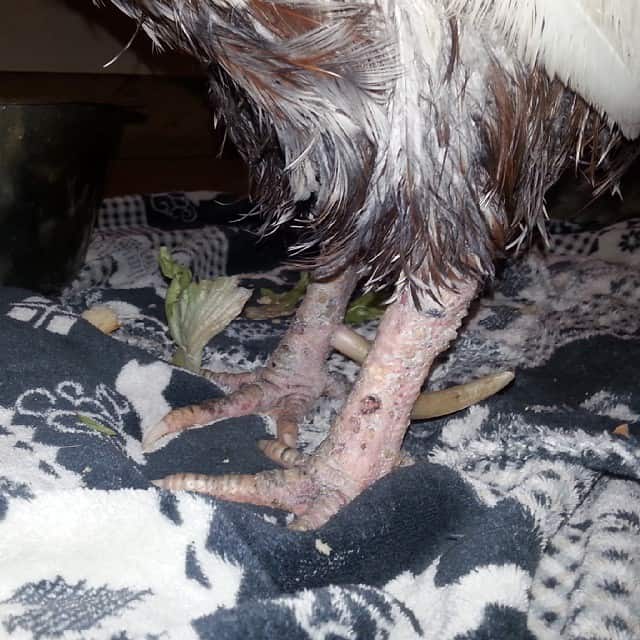
Scaly-leg mites are tiny burrowing mites that spend their entire lives on the host. They’re transmitted from bird to bird or by contact with an infested bird’s environment.
Scaly leg mites burrow under the scales of your chickens’ feet and legs, feeding on keratin and causing unimaginable pain and irritation. The burrowing also leaves tunnels and fecal matter that may lead to secondary infections.
These mites may also attack the combs and wattles of affected birds. Though they’re too small to be seen by the naked eye, you will notice crusty scabs and lumps on the scales of the legs of affected birds.
On that note, if you suspect a case of scaly leg mites, scrape off a bit of the crust on your bird’s leg or feet. Take the sample to your local vet or lab tech and have them examine it.
Long-term infestation could have adverse effects on your chicken. First, it could lead to your chickens becoming lame and having difficulty roosting. It could also lead to deformity of the toes and limping.
2. Depluming Mites (Knemidocoptes gallinae)
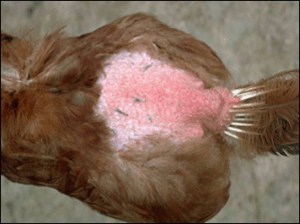
Depluming mites are closely related to scaly leg mites. However, instead of burrowing into the scales, the mites burrow into the skin around the feather shaft of your chickens.
Chicken feathers are mainly made up of protein. Depluming mites burrow into the shaft, sucking out all the nutrients. This causes the bird intense pain and irritation, forcing it to pluck out its feathers to alleviate its suffering and get rid of the mites.
If the mites reach high levels, your chickens can lose weight, reduce egg production, and even die.
These mites usually attack the head, neck, upper body, and belly of the chicken. But if you want to be certain, take skin scrapping from these regions and take it to your local vet to look for mites.
3. Red Mites (Dermanyssus gallinae)
Red mites or roost mites are the most common bird mites in the U.K. and most of Europe. Unlike other mites, red mites are nocturnal. They usually hide in the coop during the day and only emerge to feed at nighttime. Furthermore, they exclusively feed on blood.
Thus, if you’re checking for red mites, you should inspect any cracks and crevices in the wood, roosts, or nesting boxes inside your chicken coop. You could also check the chicken poop.
Most mites tend to live for about five to seven days. But red mites, as opposed to the others, have a longer life span of up to two weeks.
As said earlier, red mites could also prove a nuisance to eradicate, as they can survive up to ten months without a host or food.
To identify if you have a red mite infestation, look for black or red spots on the skin of your chicken at night with a torch.
4. Northern Fowl Mites (Ornithonyssus sylviarum)
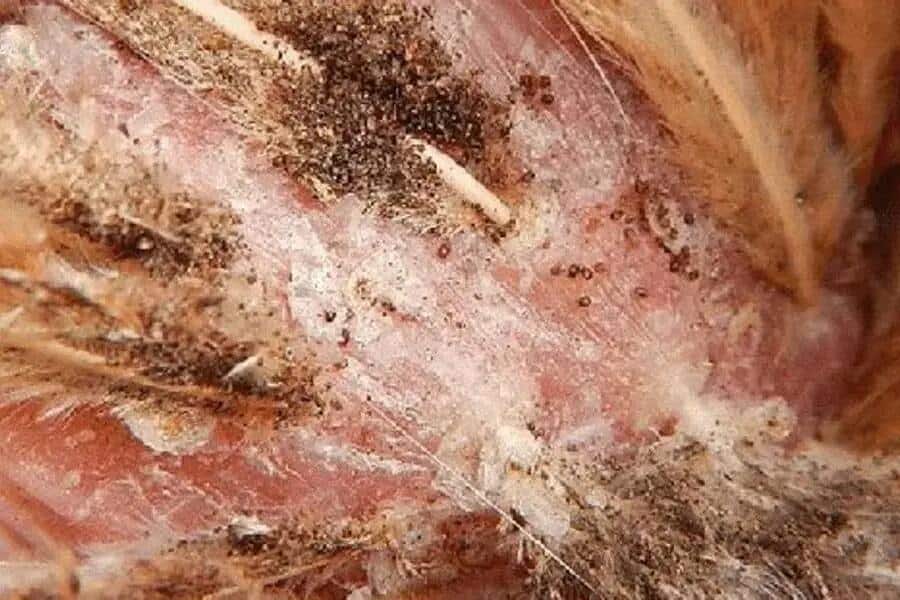
The Northern fowl mites are arguably the most poultry mites across the United States and the world. These eight-legged creatures thrive in cool temperate zones.
The mites live their entire life on the host, where they feed on blood. Birds infected with Northern fowl mites often display several symptoms, including:
- Increased preening and scratching
- Pale combs
- Blackened feathering around vents
- Restless
- Blood stains on eggs
If left untreated, a severe infestation could lead to anemia, feather loss, stunted growth, reduced egg production, and death.
Though difficult to detect at an early stage, a chicken affected by these mites will lay eggs with blood spots on them. Also, you might notice a cluster of white eggs around the feather shafts.
5. Tropical Fowl Mites (Ornithonyssus bursa)
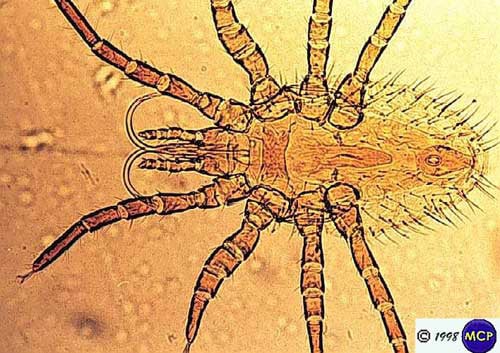
As a relative of the Northern fowl mites, these mites thrive in tropical and sub-tropical areas. Some regions plagued with these pesky parasites include the southern and central states of the U.S., Australia, and South America.
Tropical fowl mites cause severe itching, feather loss, balding, dermatitis, and anemia among chickens. These mites live on the chicken but can survive for about three weeks without a meal.
Once in a while, tropical fowl mites can become pests to people, especially in areas with high wild bird populations. Their bite is known to cause avian mite ascariasis, which results in intense itching, swelling, and dermatitis.
How Do Chicken Mites Get Transmitted?
I. Rodents/Birds
Wild birds are the primary culprit behind chicken mite infestations. When wild birds roost on roofs or areas near chicken coops, they can spread the mites to your girls.
So, it’s crucial to avoid interactions between jungle fowl and your domesticated birds to avoid a case of mite infestation.
As for rodents, they might be attracted to the chicken coop if there’s some food lying around. As such, they can bring with them menacing mites.
II. Human Carriers
Mites cannot survive on humans for a long time. However, they can attach themselves to humans until they find better hosts.
So, it’s no surprise to find a mite or two hiding in your clothes or shoes, particularly after taking a stroll in the park or woods. The mites will hang around until they find a suitable host (your chicken).
If you want to prevent an infestation, limit your interaction with your flock after visiting areas with potential mite populations. If you must visit the coop, then change your clothes to avoid spreading the mites.
III. New Fowls
Introducing new chickens to your flock is one surefire way to bring mites into your coop.
Before introducing a new bird, quarantine it first and ensure it is free from mites. This way, you can prevent unnecessary infestation.
Common Signs and Symptoms of Chicken Mites
So, how can you tell if your chickens have mites?
If your feathered friends seem irritable or scratch themselves more than usual, you’re likely dealing with chicken mites. Since these pests can impend your poultry production efforts, watch out for these signs and symptoms of an infestation:
- Excessive Preening: If your chickens groom themselves more than usual, it might be a sign that they have mites. Also, watch out for chickens pecking their feathers until they bleed. It implies their skin is irritated, and they’re trying to rid themselves of the parasite.
- Feather Loss: While it is normal for chickens to lose feathers, you should watch out for any feather loss that doesn’t align with the annual molt season. Furthermore, if your birds are only losing feathers around their wings and vent area, it might be a sign of mite infestation.
- Loss of Appetite and Lethargy: A mite-infested chicken usually eats less than its usual rations. As such, you will notice that your chickens have become listless and inactive.
- Decreased Egg Production: The restlessness and stress caused by the constant mite bites can disrupt egg production. Even if your chatty friends lay any eggs, you might notice several tiny blood spots on the eggshells.
- Reluctance to indulge in normal behaviors: If you notice your chickens refusing to go into their nesting boxes or coops, it might be a sign of infestation.
- Mites visible on chickens: If you are dealing with an infestation, you might see mites (as tiny red or black dots) on your birds’ skin. This holds particularly if you inspect under their wings, feathers, and around the vent area.
How to Eliminate Chicken Mites?
Upon identifying chicken mites in your backyard chicken, it’s crucial to take action. Sure! Eliminating these menacing creatures is not an easy undertaking, but with the help of these treatment options, you might have some success:
Diatomaceous Earth
Sprinkle diatomaceous earth on the floor of the coop, in nesting boxes, and on the chicken to get rid of mites.
This white powder features sharp edges that cut the mites’ tough exoskeleton, dehydrating and eventually killing them.
For the best results, reapply the powder every day to get rid of the mites. The same applies after rain.
While food-grade diatomaceous earth is non-toxic, it’s made up of fine particles that can irritate when inhaled by chickens and humans. Therefore, wear a mask when applying diatomaceous earth.
Ivermectin
Ivermectin is arguably the best solution to depluming and scaly leg mites. The anti-parasitic drug prevents mites from reproducing, which eliminates them from under the chicken feathers.
However, repeated treatments are necessary to kill any newly hatched mite on the chicken’s skin.
On that note, remember to abstain from harvesting and eating eggs for about two weeks after administering the drug.
Chemical Sprays
Another solution is to use pesticides with permethrin or pyrethrin. These chemical compounds will kill the mites on contact.
Spray the chemicals in the coops, nesting boxes, and roosting areas. As with any treatment, reapplication is the key to preventing newly hatched mites from causing an infestation.
Natural Remedies for Chicken Mites
Besides the solutions mentioned above, here are a few natural treatment options to help you fight against chicken mites:
Oil Sprays
You can make an oil spray by mixing two cups of water, one cup of cooking oil, and one tablespoon of dish soap.
But before application, remove all bedding (replace with new ones later). Douse the floors, walls, nesting boxes, and perches with the solution.
The oil spray suffocates the mites and kills them. For better results, use this spray twice a week in the coop.
Herbs Sprays
Most herbs naturally have a very potent scent that can repel most poultry pests, chicken mites included.
Some of the most effective herbs include wormwood, chamomile, neem oil, thyme, lavender garlic, and so on.
Use these ingredients to make an herbal spray and apply it to the chicken coop to deter mites. Remember to reapply the solution after rain or every few days to maintain its potency.
Dust Baths
Chickens have a natural way of getting rid of external parasites like fleas, lice, and mites. All they have to do is dust bathe. The tossing and turning helps to dislodge and remove mites from under feathers.
The dusting materials also enter in between feathers, suffocating the parasites and eventually killing them.
To encourage your flock to dust bathe regularly, create dust baths in the coop and run and fill them with sand, wood ash, or food-grade diatomaceous earth.
How to Prevent a Chicken Mite Infestation in Your Flock
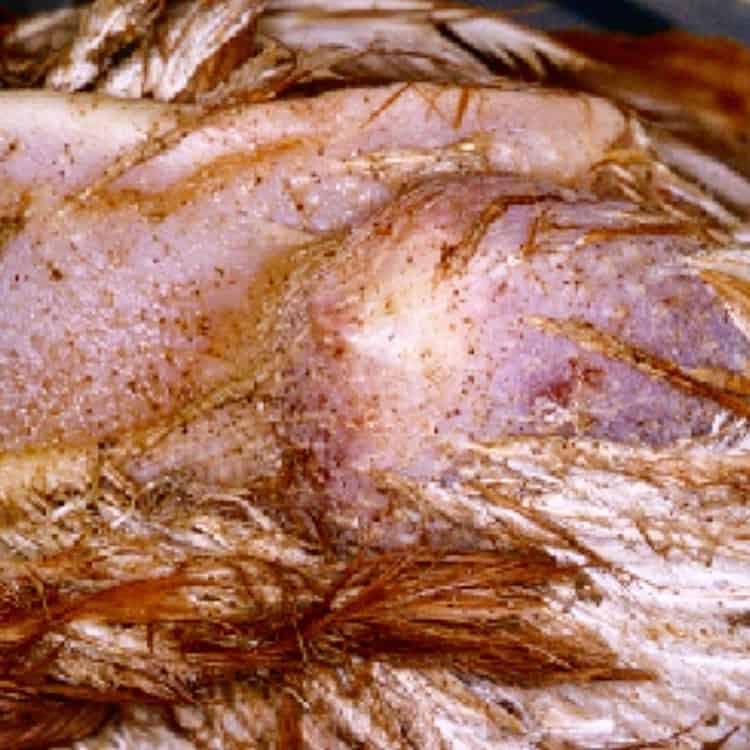
Clean Your Chicken Coop
Keeping your coop clean is the first step in preventing a mite infestation. Replace soiled chicken bedding regularly with fresh, dry bedding.
Keep the coop well-ventilated and clean all the roosting perches and nesting boxes. It also helps to scrub waterers and feeders to avoid attracting mites.
Keep a Dust Bath in the Coop
Ensure that your chickens always have a place to play in the dust. Dust baths help your chicken shed off any mites or lice. The dust will cling to the mites, dehydrating and killing them.
Dust baths also help your girls keep their feathers clean and spread natural oils throughout their bodies.
It’s advisable to use wood ash or diatomaceous earth as your dust bath. Also, ensure the dust bath is always dry.
Treat the Coop with DE
While not a lot of people are comfortable using diatomaceous earth in their coops, it works wonders for keeping mites at bay.
For this reason, you could sprinkle some of it on the floor before you put new bedding. You could also dust the roosts, perches, and nesting boxes.
Regular Inspections
As a poultry farmer, it’s critical to inspect your birds for mites and other external parasites. Keep a keen eye on minor changes in the behavior or physical health of your chickens, as these could indicate an infestation.
To identify mites, look for tiny red or black moving dots under the wings, around the vents, or at the base of your birds’ feathers.
Keep in mind that spotting an infestation early makes treatment much easier.
Also Read:
Closing Thoughts
That marks the end of our piece. But before we go, let’s remind ourselves of a few things we have learned.
Mites thrive on the chicken skin, living off its blood. But we have different types of mites, each with unique characteristics. For instance, scaly leg mites live on the bird’s leg, eating keratin and causing irritation and crusty scabs.
Despite their resilient nature, you can get rid of chicken mites using treatments like diatomaceous earth and chemical spray. Or you can opt for natural methods like dust baths and herb sprays.
But to keep these pesky pests away for good, practice good coop hygiene and inspect your chickens regularly.
Trust us! Once you vanquish these mini vampires, your birds will thank you. And you will sleep more soundly at night knowing they are healthy and happy.
